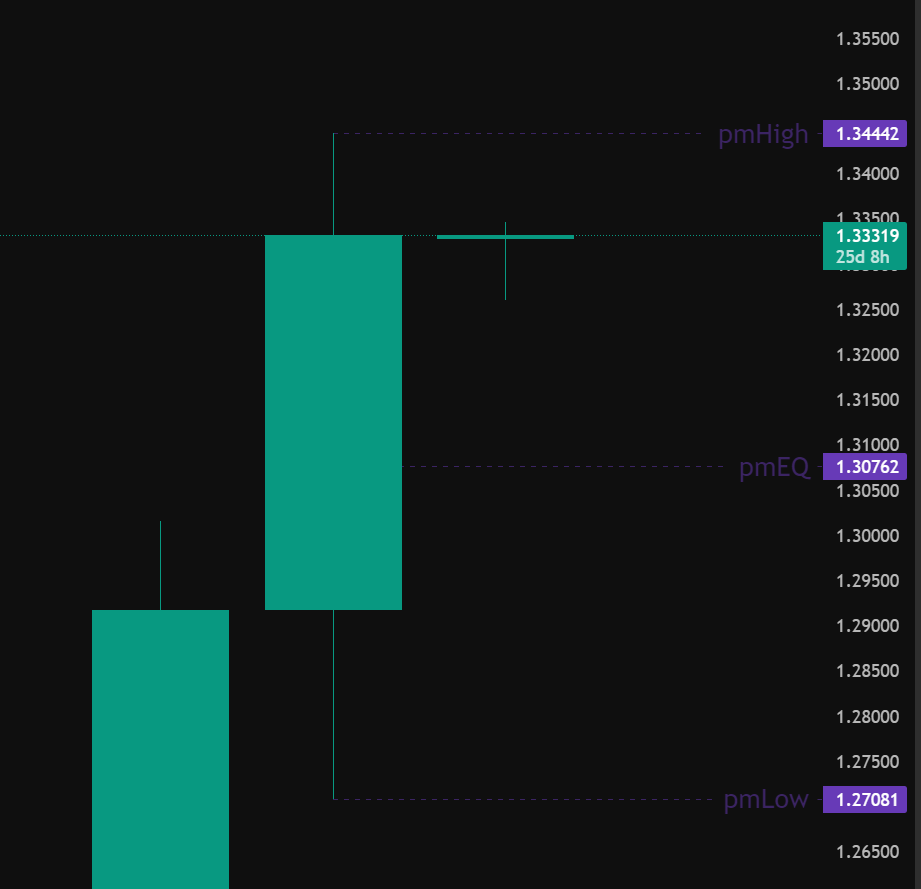While daily and weekly levels offer valuable short-to-medium term perspectives, sometimes you need to zoom out even further to truly understand the underlying currents of the market. This is where the Previous Month High (PMH), Previous Month Low (PML), and Previous Month Equilibrium come into play, acting as significant landmarks on the longer-term trading map and providing a powerful foundation for strategic decision-making.

Think of the past month as a major chapter in the market’s ongoing saga. The PMH represents the pinnacle of bullish conviction achieved during that entire period, a level where buyers demonstrated their ultimate strength. Conversely, the PML marks the trough of bearish sentiment, the point where sellers reached their maximum influence or buyers mounted a significant defence.
Finding the Monthly Center: The Equilibrium Point
Just as with daily and weekly levels, the Previous Month Equilibrium aims to pinpoint the area of relative balance between buying and selling forces throughout the entire preceding month. Common calculations include:
- Monthly Midpoint: The simplest measure, calculated as the average of the PMH and PML: PMH+PML / 2
- Monthly VWAP: The volume-weighted average price across all trading days of the previous month, offering a volume-informed perspective on the month’s “fair” price.
- Monthly Point of Control (POC): The price level that witnessed the highest volume of trading activity throughout the entire previous month, highlighting the area of most significant interest.
This monthly equilibrium can act as a powerful gravitational force in the current month, often attracting price as traders assess the longer-term value proposition and potential direction.
Strategic Advantages of Monthly Levels:
Integrating these monthly milestones into your analysis can unlock unique strategic advantages:
- Identifying Dominant Long-Term Bias: A decisive break and sustained trading above the PMH can signal a potential shift towards a longer-term bullish trend, favoring strategies that capitalize on upward momentum. Conversely, persistent trading below the PML might suggest a prevailing bearish sentiment, leaning towards short-focused approaches.
- Pinpointing Major Support and Resistance Zones: The PML and PMH often act as significant long-term support and resistance levels. These zones can be prime areas for initiating swing trades or position trades, anticipating bounces or reversals based on the previous month’s established boundaries.
- Confirmation for Lower Timeframe Setups: When daily or weekly trading signals align with a test or break of a monthly level, it adds a layer of high-probability confluence to your trade. A daily breakout occurring near the PMH, for instance, strengthens the bullish case on a broader timeframe.
- Strategic Stop-Loss Placement for Longer-Term Trades: Positioning stop-loss orders beyond the PMH or PML provides a wider safety net for longer-duration trades, accounting for potential short-term volatility while respecting the established monthly range.
- Understanding Institutional Positioning: Monthly highs and lows can often reflect the accumulation or distribution activities of larger institutional players over an extended period. Observing how price interacts with these levels in the current month can offer insights into potential institutional bias.
- Anticipating Major Trend Changes: Breaching a significant previous month high or low, especially after a period of consolidation, can signal the potential start of a significant trend reversal on a higher timeframe.
- Combining with Yearly Levels: For the ultimate long-term perspective, analyze how monthly levels interact with the previous year’s high, low, and equilibrium. Confluence across these extended timeframes can highlight exceptionally strong areas of potential support or resistance, relevant for long-term investors and position traders.
Crucial Considerations for Monthly Analysis:
- Lower Frequency: Monthly levels are less dynamic than daily or weekly levels. Breaches can be more significant but also less frequent.
- Economic and Fundamental Drivers: Major economic events, policy changes, or fundamental news released during the previous month can heavily influence the significance of the PMH and PML. Always consider the underlying context.
- Patience and Confirmation: Trading based on monthly levels often requires more patience as price may take time to interact with these zones. Look for strong confirmation signals before initiating trades.
The Bigger Picture Advantage:
Incorporating the Previous Month High, Low, and Equilibrium into your trading analysis provides a crucial longer-term perspective. It allows you to see beyond the daily noise and identify significant areas of interest that have proven their relevance over an entire month of trading activity. By understanding the story the market told last month, you equip yourself with a powerful framework for anticipating potential long-term moves and developing more strategic and informed trading decisions. So, take a step back, consult the monthly chart, and unlock the insights held within the previous month’s map.
